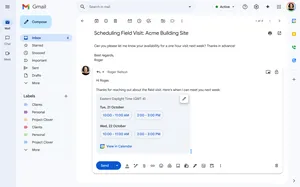A productivity expert’s tips for returning to the office

Two years ago, as many of us were thrown into remote work, I wrote a blog post about tips for working from home. Now, as many of us find ourselves returning to the office or preparing to do so soon, I wanted to talk about a few ways we can transition productively to (yet another) new (er, maybe old?) working environment where some of us are in the office, some aren’t…or some combination of the above.
Here are my top 10 tips for being productive in a hybrid work environment:
- Make sure people know where you are. Nothing screams inefficiency more than hundreds of emails and calendar invites (and invite changes) where everyone is trying to figure out who is where, when and on what days. Take the guesswork out of it by setting your working location and your working hours in Calendar, and RSVP to meetings with your location.
- Add other responsibilities to Google Calendar. Do you have commute time? School drop off? Moving to a different office campus mid-day? Add it to your Calendar now; consider making these OOO events so they auto decline if they are scheduled over.
- Optimize your calendar for connection and focus. Chances are good that you either find it easier to focus at home or in the workplace. As you consider the hybrid work options available to you, think about where you want to get your best focused work done and build it into your calendar. Wherever it happens, minimize distractions (mute notifications, use noise-canceling headphones) and schedule Focus Time in your calendar so colleagues know that you’re heads down.
- Keep your “hot spots” and your “not spots.” Our brain makes associations with the sights, sounds and smells of places and when we do an activity in the same place regularly, it makes it easier to "get in the zone" each time we go back to that same spot. Keep “hot spots” in your house and at work where you do certain things. “I always code at my desk,” “I always answer customer emails from this cafe in my building,” “I always sit on my front porch to read industry news.” Your brain will associate those spots with those things and make switching between tasks easier. Similarly, safeguard your “not spots” — places you NEVER work. If you’ve never worked in a spot, like your bedroom, it’s easy to relax there because your brain only associates it with relaxation.
- Group meetings by type, content and location wherever possible. Many people think of their schedule like a puzzle: “Sure, wherever you find a 30-minute slot, throw a meeting in there!” But your energy and focus are changing (and challenged) when you bounce from a one one one meeting to a brainstorm to a project check-in…the list goes on and on . Be intentional about when you place meetings as much as possible. Group meetings of similar type and topic, especially given the new variety in location. Theme your days and minimize switching topics and types of meeting. Call Tuesday your “Project A” day, and place work time and meetings for that project on that day. If Wednesday morning is your manager’s staff meeting, block time afterwards to digest updates and trickle down information to your team as needed.

6. Build in some things that happen every day. To give yourself some consistency, try finding 1-3 things that you do every day, no matter where you’re working. If you commute from 8:15 a.m.-9 a.m. into the office and listen to an audiobook, go on a walk and listen to your book during the same time period. If you always take a walk at home after lunch, do it at work, too. Always get an afternoon coffee at the office? Make yourself a latte at home. These signals help you keep your flow and make it a consistent “work day” no matter where you are.
7. Make a daily plan every night. At the beginning of the pandemic, I saw a surge in the use of the planning resources. People had gotten used to “showing up” in an office every morning, then deciding what to do with their time. Working from home required people to figure out exactly what they were doing and when. This type of planning is still important as you bounce back and forth to different work environments with different types of schedules. Fill out daily plan *the night before* to make the most of the following day. What you intend to do will marinate while you sleep and you’ll approach the day focused and intentional.
8. A new “season” of work calls for spring cleaning . A new schedule at the office, much like the New Year or a new job, is a great time for a “spring cleaning” of your work life. Do you need to keep that recurring meeting you set up two years ago to keep in touch with people you'll now see in the office? Should your team be meeting in-person on a different day given everyone’s locations? Do you need to lighten up your schedule to make more time for travel?
9. Write down three things you learned from working from home and take them with you. Working from home was a time of discovery for many of us. Let’s not lose those insights as we head back to the office. Maybe you realized you work best after a mid-morning workout, or that you get burnt out if you start work before 9 a.m. Take a moment to write down three things you learned and build them into your new schedule.
10. Take time to adjust. Two years ago, no one had any idea we’d be at home for so long. And during that time, many of us became great at being productive while working remotely. Others realized they definitely wanted to go back to the office. Whatever your preference, we gave each other grace. Let’s do the same this time as many of us transition yet again, and continue extending it to those who will remain remote.






